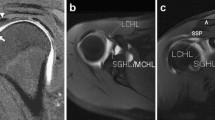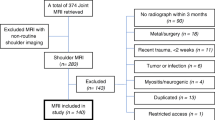Abstract
Purpose
The purpose of this study was to determine whether there is an association between the critical shoulder angle (CSA) and rotator cuff tears (RCT) as well as osteoarthritis (OA), and to compare the reproducibility and accuracy of CSA values as measured with radiograph and MRI.
Methods
Based on a pre hoc power analysis, three independent reviewers measured CSAs for three groups of 10 age-matched patients each (RCT group, OA group, and non-RCT/non-OA group) using radiographs and MRIs. Inter- and intra-observer agreements of CSAs were determined with intraclass correlation coefficients. ANOVA analysis was performed.
Results
Interobserver and intra-observer agreements on radiographs were 0.87 (95 % CI 0.78–0.93) and 0.91 (95 % CI 0.82–0.96), respectively. Significant differences in mean CSAs by radiographs were found between the groups (RCT 37.3° ± 2.6°; OA 28.7° ± 2.2°; non-RCT/non-OA 32.7° ± 2.5°; p < 0.001). CSAs obtained from MRI scans had interobserver agreement of 0.62 (95 % CI 0.43–0.78) and intra-observer agreement of 0.68 (95 % CI 0.50–0.80). There was a significant correlation between the patients’ pathologies and CSAs measured by radiographs (r = 0.44; p = 0.02) and MRI (r = 0.50; p = 0.01). A significant difference in mean CSAs measured on radiograph versus MRI was seen in the OA group (28.7° ± 2.2° vs. 31.3° ± 4.4°; p = 0.01).
Conclusion
CSA measurements obtained from radiographs demonstrated excellent interobserver agreement with less variability than CSAs from MRI, especially in OA patients. This study confirms an association between the CSA and RCTs as well as OA pathology. Assessing the CSA may be helpful during diagnostic evaluation of patients with shoulder pain and can help predict pathology.
Level of evidence
Retrospective cohort study, Level IV.






Similar content being viewed by others
References
Ames JB, Horan MP, Van der Meijden OA, Leake MJ, Millett PJ (2012) Association between acromial index and outcomes following arthroscopic repair of full-thickness rotator cuff tears. J Bone Joint Surg Am 94:1862–1869
Bhatia S, Hsu A, Lin EC, Chalmers P, Ellman M, Cole BJ, Verma NN (2012) Surgical treatment options for the young and active middle-aged patient with glenohumeral arthritis. Adv Orthop 2012:1–8
Bigliani LU, Ticker JB, Flatow EL, Soslowsky LJ, Mow VC (1991) The relationship of acromial architecture to rotator cuff disease. Clin Sports Med 10:823–838
Davidson PA, Elattrache NS, Jobe CM, Jobe FW (1995) Rotator cuff and posterior-superior glenoid labrum injury associated with increased glenohumeral motion: a new site of im**ement. J Shoulder Elbow Surg 4:384–390
DeOrio JK, Cofield RH (1984) Results of a second attempt at surgical repair of a failed initial rotator-cuff repair. J Bone Joint Surg Am 66:563–567
Drӧge W (2003) Oxidative stress and aging. Adv Exp Med Biol 543:191–200
Funakoshi T, Iwasaki N, Kamishima T, Nishida M, Ito Y, Kondo M, Minami A (2010) In vivo visualization of vascular patterns of rotator cuff tears using contrast-enhanced ultrasound. Am J Sports Med 38:2464–2471
Gerber C, Rahm SA, Catanzaro S, Farshad M, Moor BK (2013) Latissimus dorsi tendon transfer for treatment of irreparable posterosuperior rotator cuff tears: long-term results at a minimum follow-up of 10 years. J Bone Joint Surg Am 95:1920–1926
Hamid N, Omid R, Yamaguchi K, Steger-May K, Stobbs G, Keener JD (2012) Relationship of radiographic acromial characteristics and rotator cuff disease: a prospective investigation of clinical, radiographic, and sonographic findings. J Shoulder Elbow Surg 10:1289–1298
Hashimoto T, Nobuhara K, Hamada T (2003) Pathologic evidence of degeneration as a primary cause of rotator cuff tear. Clin Orthop Relat Res 415:111–120
Hughes RE, Bryant CR, Hall JM, Wening J, Huston LJ, Kuhn JE, Carpenter JE, Blasier RB (2003) Glenoid inclination is associated with full-thickness rotator cuff tears. Clin Orthop Relat Res 407:86–91
Kim JR, Ryu KJ, Hong IT, Kim BK, Kim JH (2012) Can a high acromion index predict rotator cuff tears? Int Orthop 36:1019–1024
Landis JR, Koch GG (1977) The measurement of observer agreement for categorical data. Biometrics 33:159–174
Lenza M, Buchbinder R, Takwoingi Y, Johnston RV, Hanchard NC, Faloppa F (2013) Magnetic resonance imaging, magnetic resonance arthrography. Cochrane Database Syst Rev 24(9):CD009020
Miyazaki AN, Itoi E, Sano H, Fregoneze M, Santos PD, da Silva LA, Sella Gdo V, Martel EM, Debom LG, Andrade ML, Checchia SL (2011) Comparison between the acromion index and rotator cuff tears in the Brazilian and Japanese populations. J Shoulder Elbow Surg 20:1082–1086
Moor BK, Bouaicha S, Rothenfluh DA, Sukthankar A, Gerber C (2013) Is there an association between the individual anatomy of the scapula and the development of rotator cuff tears or osteoarthritis of the glenohumeral joint? A radiological study of the critical shoulder angle. Bone Joint J 95-B:935–941
Neer CS 2nd (1972) Anterior acromioplasty for the chronic im**ement syndrome in the shoulder: a preliminary report. J Bone Joint Surg Am 54:41–50
Nove-Josserand L, Edwards TB, O’Connor DP, Walch G (2005) The acromiohumeral and coracohumeral intervals are abnormal in rotator cuff tears with muscular fatty degeneration. Clin Orthop Relat Res 433:90–96
Nyffeler RW, Werner CM, Sukthankar A, Schmid MR, Gerber C (2006) Association of a large lateral extension of the acromion with rotator cuff tears. J Bone Joint Surg Am 88:800–805
Outerbridge RE (1961) The etiology of chondromalacia patellae. J Bone Joint Surg Br 43-B:752–757
Patte D (1990) Classification of rotator cuff lesions. Clin Orthop Relat Res 254:81–86
Steinbach LS (2008) MRI of shoulder instability. Eur J Radiol 68:57–71
Zumstein MA, Jost B, Hempel J, Hodler J, Gerber C (2008) The clinical and structural long-term results of open repair of massive tears of the rotator cuff. J Bone Joint Surg Am 90:2423–2431
Author information
Authors and Affiliations
Corresponding author
Rights and permissions
About this article
Cite this article
Spiegl, U.J., Horan, M.P., Smith, S.W. et al. The critical shoulder angle is associated with rotator cuff tears and shoulder osteoarthritis and is better assessed with radiographs over MRI. Knee Surg Sports Traumatol Arthrosc 24, 2244–2251 (2016). https://doi.org/10.1007/s00167-015-3587-7
Received:
Accepted:
Published:
Issue Date:
DOI: https://doi.org/10.1007/s00167-015-3587-7




